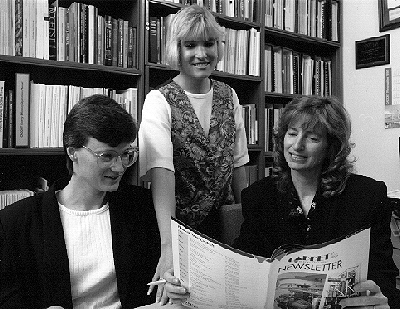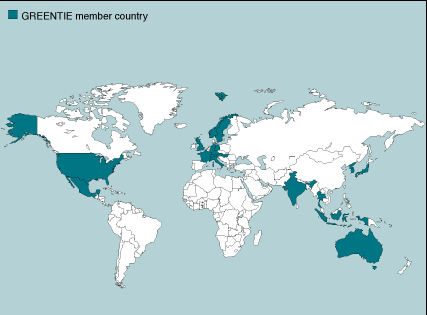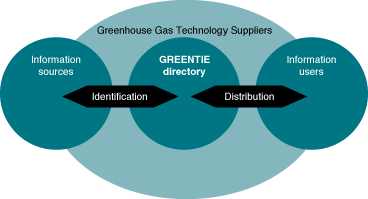
By Marilyn A. Brown, Julia S. Kelley, and Melissa K. Voss
 Increasing emissions of greenhouse gases from human activities are predicted to lead to significant global warming and possibly undesirable environmental effects by the middle
of the next century. These gases trap solar energy that is reradiated from the
earth's surface, raising its temperature. The gases—carbon dioxide, methane,
nitrous oxide, and chlorofluorocarbons (CFCs)—are emitted as the result of a
wide range of anthropogenic activities, including the production and conversion
of energy from fossil fuels, the operation of air conditioning and
refrigeration equipment, coal mining,
domestic sewage treatment, and the manufacture of cement and nylon. To slow
global warming, technologies are being developed, promoted, and deployed to
reduce these emissions.
Increasing emissions of greenhouse gases from human activities are predicted to lead to significant global warming and possibly undesirable environmental effects by the middle
of the next century. These gases trap solar energy that is reradiated from the
earth's surface, raising its temperature. The gases—carbon dioxide, methane,
nitrous oxide, and chlorofluorocarbons (CFCs)—are emitted as the result of a
wide range of anthropogenic activities, including the production and conversion
of energy from fossil fuels, the operation of air conditioning and
refrigeration equipment, coal mining,
domestic sewage treatment, and the manufacture of cement and nylon. To slow
global warming, technologies are being developed, promoted, and deployed to
reduce these emissions.
 Julia Kelley (left), Melissa Voss, and Marilyn Brown examine the latest issue of the CADDET Newsletter, which covers the work of the Center for the
Analysis and Dissemination of Demonstrated Energy Technologies.
Julia Kelley (left), Melissa Voss, and Marilyn Brown examine the latest issue of the CADDET Newsletter, which covers the work of the Center for the
Analysis and Dissemination of Demonstrated Energy Technologies.
To make a practical response to global environmental issues such as
greenhouse gas emissions, it is recognized that international collaboration is
needed. Because of the accelerating pace of technology innovation and the
increasingly interconnected world economy, national efforts to adapt to global
environmental challenges are no longer sufficient. Through international
collaboration, scarce resources can be shared and technological solutions can
be adapted and replicated.
Several international cooperative agreements are now in place to accelerate
worldwide deployment of technologies that mitigate greenhouse gas emissions,
and ORNL staff perform work in support of these agreements. Because energy
efficiency and renewable energy technologies have vast potential for reducing
greenhouse gas emissions, much of the support for these international
activities comes from DOE's Office of Energy Efficiency and Renewable Energy,
which funds the ORNL work. In supporting these activities, DOE recognizes the
importance of developing foreign as well as domestic markets for new and
improved high-efficiency and renewable energy technologies produced in the
United States. Widespread deployment of these technologies should reduce energy
costs to consumers, improve the nation's standard of living, increase energy
security, and enhance environmental quality.
Because of its exploding population, increasing buying power, and growing
energy consumption, the developing world is a key market for energy-efficiency
and renewable energy technologies. The two main forces driving energy demand in
developing countries have been population growth and economic development. The
growth in energy use has for some time been fastest in developing countries. In
the past decade, for instance, the demand for energy in the developing world
has grown by 49%, compared with a 14% increase in the developed world. At these
rates of growth, the World Energy Council Commission estimated in 1993 that, by
2010, developing countries will account for the major part of the world's
greenhouse gas emissions from burning fuels.
To date, 150 countries have signed the United Nations Framework Convention
on Climate Change, which commits them to work toward controlling and reducing
greenhouse gas emissions. Thus, there is a sizeable commitment around the world
to implementing greenhouse gas mitigation technologies. The International
Energy Agency (IEA) has established a number of information centers that assist
the efforts of these countries. ORNL's role in supporting one of these
centers—the Greenhouse Gas Technology Information Exchange (GREENTIE)—is the
primary focus of this article, although ORNL's involvement with two other IEA
activities is also highlighted.
The IEA was created in 1974 within the framework of the Organization for Economic Cooperation and Development (OECD). It implements an international
energy program of cooperation aimed at reducing the excessive dependence on oil
among its 23 member countries, through energy conservation, development of
alternative energy sources, and energy research and development. Activities are
set up under "implementing agreements" that provide the legal mechanisms and
management structure for collaboration.
 Currently, 42 implementing agreements are in effect, covering the following
topics:
Currently, 42 implementing agreements are in effect, covering the following
topics:
- Energy technology information centers (7 agreements)
- Fossil fuel technologies (7 agreements)
- Renewable energy technologies (20 agreements)
- Nuclear fusion technologies (8 agreements).
ORNL is responsible for managing and supporting the U.S. involvement in
many of these implementing agreements. In addition to collaborating with
GREENTIE, ORNL is involved with the following other IEA implementing
agreements, either as executive committee members, national team leaders, or
operating agents: the Center for the Analysis and Dissemination of Demonstrated
Energy Technologies, Heat Pump Program, Buildings and Community Systems,
Alternative Motor Fuels, and Fusion Energy Stellerator Concept.
GREENTIE
GREENTIE was formed under the auspices of IEA in October 1993. DOE became
an official member of GREENTIE in 1994, at which point ORNL was asked to help
DOE carry out the GREENTIE mission. The GREENTIE objectives are to identify
greenhouse gas mitigation technologies that have a potential for international
deployment and to publicize the availability of these technology options to
potential decisionmakers and users. By helping to inform decisionmakers
worldwide about available greenhouse gas technologies, GREENTIE will contribute
to increased exports and unit sales of energy-efficient and renewable energy
products and will help reduce the adverse impacts of fossil-fuel consumption on
the global environment.
 These shaded countries currently participate in GREENTIE.
These shaded countries currently participate in GREENTIE.
Greenhouse gas technologies include a wide array of options for reducing
emissions of greenhouse gases. Two energy-efficiency approaches are being taken
to abate the large emissions of carbon dioxide from combustion of fossil fuels.
First, advanced technologies are being developed to improve the efficiency with
which stored energy is converted to useful energy. For example, pressurized
fluidized-bed combustion is gaining favor as an energy source because it
extracts more heat from burning coal than do other coal-combustion methods for
generating electricity. As a result of its high thermal efficiency, pressurized
fluidized-bed combustion emits less carbon dioxide per unit of energy produced
than do other types of coal power plants. Other examples include gas turbine
technologies and fuel cells.
Second, to further reduce carbon dioxide emissions from fossil-fuel
combustion, technologies are being developed to improve the efficiency with
which energy is consumed in various applications. Examples of these end-use
efficiency improvements include compact fluorescent lighting, adjustable-speed
electric motors and drives, pulse combustion boilers, and compressed natural
gas vehicles.
 In contrast to fossil energy sources, renewable energy forms such as solar,
wind, hydro, tidal, and wave energy, and the sustainable use of biomass are
either carbon-free or carbon-neutral. Thus, renewable energy technologies are
a major thrust of the GREENTIE program. GREENTIE also deals with techniques
for separating, recovering, and disposing of carbon dioxide once it has been
produced.
In contrast to fossil energy sources, renewable energy forms such as solar,
wind, hydro, tidal, and wave energy, and the sustainable use of biomass are
either carbon-free or carbon-neutral. Thus, renewable energy technologies are
a major thrust of the GREENTIE program. GREENTIE also deals with techniques
for separating, recovering, and disposing of carbon dioxide once it has been
produced.
Technologies for reducing methane emissions are similarly diverse,
reflecting the wide range of anthropogenic sources of emissions: natural gas
systems, coal mining, waste disposal, wastewater treatment, and domesticated
livestock. Examples of methane-reducing technologies include detection of leaks
of methane from and repair of natural gas pipelines, improved oil and natural
gas compressor operations, and installation of landfill gas recovery systems.
This new implementing agreement was created in response to IEA member
nations' concerns about the global rise in temperature caused by manmade
changes in the composition of the atmosphere and to their questions about
appropriate remedial action. Currently, 19 member countries participate in this
IEA implementing agreement: 13 are members of IEA/OECD and the remaining
nations are developing countries. By extending membership to non-IEA countries,
GREENTIE is acknowledging the fact that the developing world must be part of
any internationally effective program to abate greenhouse gas emissions. The
GREENTIE Center in the Netherlands acts as a focal point for information and
technology sharing among these 19 countries.
Each of the 19 member countries participates in IEA GREENTIE on a cost- and
task-shared basis. Member countries are establishing GREENTIE Liaison Groups
(GLGs) of experts to collect information on organizations in their countries
that wish to promote their organizational capabilities free of charge
internationally. Each GLG also promotes GREENTIE within its country and
provides assistance to users. The U.S. GREENTIE Liaison Group was established
by DOE in 1995, with assistance from ORNL.
 GREENTIE's primary product is a directory of information about suppliers of
products, technologies, and information related to the mitigation of greenhouse
gases. In October 1995, the GREENTIE Center in the Netherlands completed the
first edition of a directory of this supplier information and made the
directory available to all member countries. The directory, which is on the
Internet, categorizes the capabilities of suppliers in terms of the greenhouse
gases that their products and technologies help to mitigate; the economic
activities of the users of their products and technologies; and the types of
greenhouse gas mitigation technologies, products, and services they offer.
During 1995, ORNL was charged with the task of contributing directory
information on 2500 organizations located in the United States.
GREENTIE's primary product is a directory of information about suppliers of
products, technologies, and information related to the mitigation of greenhouse
gases. In October 1995, the GREENTIE Center in the Netherlands completed the
first edition of a directory of this supplier information and made the
directory available to all member countries. The directory, which is on the
Internet, categorizes the capabilities of suppliers in terms of the greenhouse
gases that their products and technologies help to mitigate; the economic
activities of the users of their products and technologies; and the types of
greenhouse gas mitigation technologies, products, and services they offer.
During 1995, ORNL was charged with the task of contributing directory
information on 2500 organizations located in the United States.
The GREENTIE directory facilitates the international exchange of
information on greenhouse gas technology options. It also enables the GREENTIE
Center and member countries to prepare customized "supplier information
packages" in response to international inquiries on greenhouse gas
technologies. Inquirers to the GREENTIE Center receive information about
technology options and companies located in the United States and other member
countries that can meet their specific needs. This information forges links
between motivated potential buyers and prospective member country suppliers.

The capabilities of organizations listed in the IEA GREENTIE directory are
categorized.
GREENTIE Concept
The GREENTIE Center coordinates its activities with other IEA implementing
agreements and publishes a free newsletter called GREENTIMES. It also promotes
GREENTIE worldwide by collaborating with other international energy or
environmental organizations and by participating in international conferences
and meetings.
 Under the GREENTIE concept, people needing information on suppliers of
greenhouse gas technologies are connected to the information sources.
Under the GREENTIE concept, people needing information on suppliers of
greenhouse gas technologies are connected to the information sources.
Included in the outlook for future GREENTIE products are (1) country-specific analyses of technology options prepared by member countries
and (2) an electronic communications capability. It is anticipated that, by
1996, an Internet-based system will connect GREENTIE to existing on-line
information sources such as DOE's Energy Efficiency and Renewable Energy
Network. GREENTIE will then be able to offer a "smart window" to a wealth of
information available globally. Potential users will be able to search the
GREENTIE directory themselves, compare technologies, and contact suppliers.
Ultimately, the combination of a directory of information on suppliers,
customized supplier information packages, country-specific technology analyses,
and liaison group activities will expedite the worldwide dissemination of
information on cost-effective technologies for reducing greenhouse gas
emissions. 
BIOGRAPHICAL Sketches
MARILYN A. BROWN is deputy director of ORNL's Energy Efficiency and Renewable
Energy Program. She has a Ph.D. degree in geography from Ohio State University
and a master's degree in resource planning from the University of
Massachusetts. Before coming to ORNL in 1984, she was an associate professor at
the University of Illinois. Her research at ORNL has examined issues
surrounding the commercialization of new energy technologies and frameworks and
methods to evaluate the impacts of federal and utility-operated conservation
and renewable energy programs. She has served on many editorial boards and
advisory panels and has authored more than 120 publications. She has received
awards for her research from the Association of American Geographers, the
Technology Transfer Society, and the Association for Women in Science.
JULIA S. KELLEY is a project manager in the Integrated Project Management
Section of Information Management Services in Lockheed Martin Energy Systems.
She received her master's degree in library and information science from the
University of Kentucky in 1987. Following a position as a research librarian at
the Knoxville News-Sentinel, she joined ORNL in 1991. She is a member of the
Amercian Society for Information Science.
MELISSA K. VOSS is a marketing analyst in the Efficiency and Renewables
Research Section of ORNL's Energy Division. Her work includes creating outreach
materials that promote energy-efficient technologies at ORNL's Buildings
Technology Center and implementing marketing strategies for three International
Energy Agency programs. In 1993, she received a master of business
administration degree in marketing from Western Illinois University and began
working at ORNL. She is a member of the American Marketing Association.
Where to?
 [ Next article | Search | Mail | Review Home Page | ORNL Home Page ]
[ Next article | Search | Mail | Review Home Page | ORNL Home Page ]
 Increasing emissions of greenhouse gases from human activities are predicted to lead to significant global warming and possibly undesirable environmental effects by the middle
of the next century. These gases trap solar energy that is reradiated from the
earth's surface, raising its temperature. The gases—carbon dioxide, methane,
nitrous oxide, and chlorofluorocarbons (CFCs)—are emitted as the result of a
wide range of anthropogenic activities, including the production and conversion
of energy from fossil fuels, the operation of air conditioning and
refrigeration equipment, coal mining,
domestic sewage treatment, and the manufacture of cement and nylon. To slow
global warming, technologies are being developed, promoted, and deployed to
reduce these emissions.
Increasing emissions of greenhouse gases from human activities are predicted to lead to significant global warming and possibly undesirable environmental effects by the middle
of the next century. These gases trap solar energy that is reradiated from the
earth's surface, raising its temperature. The gases—carbon dioxide, methane,
nitrous oxide, and chlorofluorocarbons (CFCs)—are emitted as the result of a
wide range of anthropogenic activities, including the production and conversion
of energy from fossil fuels, the operation of air conditioning and
refrigeration equipment, coal mining,
domestic sewage treatment, and the manufacture of cement and nylon. To slow
global warming, technologies are being developed, promoted, and deployed to
reduce these emissions.
 Julia Kelley (left), Melissa Voss, and Marilyn Brown examine the latest issue of the CADDET Newsletter, which covers the work of the Center for the
Analysis and Dissemination of Demonstrated Energy Technologies.
Julia Kelley (left), Melissa Voss, and Marilyn Brown examine the latest issue of the CADDET Newsletter, which covers the work of the Center for the
Analysis and Dissemination of Demonstrated Energy Technologies.
 These shaded countries currently participate in GREENTIE.
These shaded countries currently participate in GREENTIE.


 Under the GREENTIE concept, people needing information on suppliers of
greenhouse gas technologies are connected to the information sources.
Under the GREENTIE concept, people needing information on suppliers of
greenhouse gas technologies are connected to the information sources.